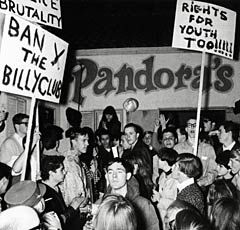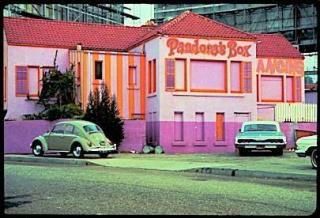Great journal topic.
My uncle is a Los Angeles native and was a Sunset Strip street urchin & participant in the Sunset Strip "riots" of 1966. He's given me the grand tour of the Strip along with his own wry observations about what happened in November 1966. I dutifully recorded an interview with him on the topic around five years ago, when he wrote a well received but little read book on the Sunset Strip scene in the Sixties.
He said the use of the word "riot" was a bit of a ridiculous term to describe the events on Sunset Strip in 1966, since most of the activities by protesters were peaceful and orderly.
It all began with the announcement of the closing Pandora's Box a popular hole-in-the-wall live music club at the corner of Sunset & Crescent Heights. Pandora's Box was the club where the Seeds, the most popular youth band of the L.A. youthquake frequently played, along with another popular garage oriented band, the Chocolate Watchband.
The cover charge at Pandora's was cheaper (usually $1) than the other three other Sunset Strip rock clubs, the Whiskey A Go Go, Ciro's and London Fog. Because of their cheap cover charge, Pandora's became the most popular hangout for underage high school kids. Unlike the other three competing clubs, Pandora's didn't have a liquor license and was technically the only club that could admit patrons under the age of 18. The drinking age in California was 21 in 1966 but an 18 year was allowed admission to music clubs that served liquor. It's a bit of an academic question because L.A. police patrolmen earned a nice supplementary income from club owners who paid them to ignore underage drinking violations in the Strip's rock clubs.
The ambiance of Pandora's Box seemed coffee house than a rock music club. The staff of Pandora's were amicable and friendly especially for L.A. rock club employees who had a reputation for acting more like rock stars than the rock stars who played their venues.
On the dark side of things, Pandora's became a prowling grounds for B-list Hollywood actors and entertainment industry executives who were seeking underage high school girls for sexual encounters. Most frequent among those Hollywood customers at Pandora's were Jack Nicholson, Peter Fonda and Dennis Hopper, a trio of B-movie actors who had developed a large following of youthquake kids with their roles anti-hero types in many of director Roger Corman's teen exploitation films. The trio's club hopping entourage was comprised of an exotic collection of characters from the underground fringe of the B-movie industry and often included actors Bruce Dern, Dean Stockwell, Michael J. Pollard, aspiring & film director Bob Rafelson, and a pair of beautiful aspiring actresses with exquisite Hollywood pedigrees: Susan Stratsberg, daughter of legendary actor Lee Stratsberg who developed the revolutionary practice of method acting and Angelica Houston, daughter of legendary film director John Houston. In 1969 Nicholson, Hopper and Fonda would establish their careers as bankable A-list movie stars by starring in
Easy Rider .
The events leading to the Sunset Strip revolved around the mundane issue of police enforcement of local curfew laws. Acting on noise and loitering complaints from merchants and local residents, the LAPD began doing patrols on the Strip to enforce the 10 p.m. curfew for minors under the age of 18 in the summer of 1966. The police spent targeted their enthusiasm for curfew enforcement primarily on Pandora's club goers while ignoring the other rock music clubs.
Down the street, The Whiskey A Go-Go booked the top tier L.A. bands with major label contracts while Pandora's featured less polished indie label garage bands who were regarded as outsiders by many L.A. music industry professionals. The Whiskey's connection with some of the most L.A.'s most powerful entertainment industry executives created an informal police policy in which officers frequently ignored curfew and peace disturbance violations by the Whiskey A Go Go's patrons, while they dutifully targeted Pandora's customers for curfew, loitering and peace disturbance violations.
There were long haired Bohemian types who frequented Pandora's but for the most part, Pandora's customers were kids from affluent families in suburban L.A. counties. By contemporary standards, most of Pandora's clientele dressed like preppies who were a few weeks late on a trip to the barbershop.
There were drug dealers who patronized & sold marijuana at all of the Sunset Strip clubs, including the posh Playboy key club, but Pandora's was frequently portrayed by L.A.'s civic leaders as a den of marijuana dealers who were hellbent on corrupting the innocent children of Los Angeles. Parents of high school kids in all of L.A.'s suburban counties were advised by their civic leaders to keep their children away the vile decadence of the Sunset Strip rock music clubs, especially Pandora's Box.
No one really remembers if Pandora's Box owner announced the closing or if the police closed the club because of the frequent peace disturbance complaints. But young rock fans interpreted efforts to enforce curfew and loitering laws as an infringement on their civil rights.
 A snapshot of Sunset Strip demonstration on the parking lot in front of Pandora's Box from November 1966.
A snapshot of Sunset Strip demonstration on the parking lot in front of Pandora's Box from November 1966.
On the second week of November, 1966, fliers were distributed along the Strip inviting people to demonstrate against the closing of Pandora's Box. On the day of the demonstration, rock 'n' roll radio stations made an announcement that there would be a rally at Pandora's Box but warned people to assemble peacefully. About 1000 people showed up for the demonstration, including two actors who were most often associated with the scene at Pandora's Box, Peter Fonda & Jack Nicholson. My uncle said "hippie" was the generic term used to describe the Sunset Strip kids back in 1966, but the term "hippie" fell into popular usage to describe the young people during the Summer of Love in San Francisco in 1967. Sky Saxon the lead singer of the Seeds coined the term "flower power" and described himself as a hippie in early 1966.
The demonstration began peacefully with protesters linking arms, singing and blocking flow of traffic on Sunset Blvd.
The "riot" began when a car full of off-duty Marines got into a fender bender with another automobile. One of the marines got into a brawl with the other driver and the fighting spread. Most of the fighting occurred among a much larger contingent of adult curiosity seekers in various stages of inebriation. When the police showed up and placed a blockade on Sunset Blvd., it made matters worse and small group of about 30 or 40 protesters broke off from the main demonstration and ran amok.
The rogue contingent of protesters rocked a city bus and forced the driver and passengers out and then broke some the windows in the bus and let the air out of the tires. One kid was arrested for arson when he allegedly attempted to drop a lighted match into the gas tank of the bus. That was the extent of the Sunset Strip "riot" except for a few incidents of bottle and rock throwing. Peter Fonda was arrested but was released when he claimed he was filming a documentary of the demonstration.
All and all the Sunset Strip riots were pretty mild, especially since a year earlier in August 1965, Watts riot in Los Angeles resulted in 34 deaths, 3500 arrests and $40 million in property damage.
The confrontations between hippies and the LAPD on the Strip continued off and on for the rest of November until about the Christmas season of 1966. Atco Record's newest superstars Sonny & Cher, who began their career as anti-establishment performers on the Sunset Strip scene, made an appearance at a rally in front of Pandora's Box in December and called for peace between the kids and the cops. Sonny & Cher's peace offering led Los Angeles County Supervisor Ernest Debs to bizarrely label them as "misguided hoodlums." The City of Los Angeles also retaliated by kicking Sonny & Cher off the float they were supposed to ride in the Rose Parade on New Years Day.
Pandora's Box opened for one last farewell night in late December and Buffalo Springfield played at the club. Buffalo Springfield guitarist Stephen Stills did the first public performance his new song about the Sunset Strip riots,
For What It's Worth...And everyone knows that
For What's It's Worth went on to become an anthem of the turbulent Sixties.
My uncle also said Pandora's Box was used as the location site for the club footage of the Chocolate Watchband's performance, in the 1967 B-movie,
Riot on Sunset Strip. The club was already closed, but the film's producer secured a city permit to use Pandora's as a location site to film the club scenes.
The following summer in August 1966, Pandora's Box was razed to realign the streets on Sunset Strip to accommodate the growing flow of tourist traffic. The owner of Pandora's Box received a six figure government check to surrender his ownership rights for the street realignment construction project. My uncle and many other Sunset Strip club regulars came to believe that Pandora's owner had planned to close the club all along from the moment he was offered a big cash settlement to sell out to the planned public works project. Some even believed the owner of Pandora's formed a tacit alliance with city hall to use the harsh curfew enforcement policy to expedite the closure of Pandora's Box, so the owner could sell off the club at the earliest possible date.
I've passed the former site of Pandora's Box a few times during my periodical visits to L.A. but there's nothing that suggest any sort of club or or any sort of building was ever located there. It's basically a traffic island near the corner Sunset Blvd. & Crescent Heights. Below is a snapshot of Pandora's Box in 1966. It was garish pink, purple and red stucco building that Architectural Digest would probably describe as a blighted eyesore on the urban landscape.
